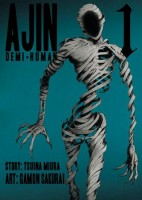 Author: Tsuina Miura
Author: Tsuina Miura
Illustrator: Gamon Sakurai
U.S. publisher: Vertical
ISBN: 9781939130846
Released: October 2014
Original release: 2013
It was the cover art of Ajin: Demi-Human, Volume 1—a creepy image of disconcerting skeletal figure—that first sparked my interest in the series. When I learned that the manga was at least in part about immortals in addition to being fairly dark in tone, I knew that I wanted to read it. The exploration of immortality and its repercussions in fiction fascinates me. Series like Hiroaki Samura’s Blade of the Immortal and novels like Fumi Nakamura’s Enma the Immortal have actually been some of my favorite works of recent years. And so, I was very curious about Ajin. The first volume, written by Tsuina Miura and illustrated by Gamon Sakurai, was originally released n Japan in 2013. (Later volumes of the series are both written and illustrated by Sakurai.) The English-language edition of Ajin, Volume 1 was published by Vertical in 2014. The production values are particularly nice, with high-quality paper that really shows off Sakurai’s ink-heavy artwork.
Seventeen years ago, the first demi-human was discovered. Immortal, and perhaps something a little more, demi-humans are considered to be less than human—feared, despised, reviled, and subjected to horrific experiments in the name of science and for the advancement of humankind. Demi-humans seem to be rare, only forty-six have so far been identified, but that’s only because they appear to be normal humans, at least until they survive their first death. Most assumed Kei Nagai was an average high schooler, preoccupied with studying for his college entrance exams. But Kei’s hopes and dreams of becoming a successful doctor are shattered when he dies in a traffic accident, his body smashed into pieces. And then he comes back to life. Now he’s on the run, pursued by the general population, the police, the Demi-Human Control Commission, and even other demi-humans. His only ally is his friend Kai, who tries to help him escape, but that simply means that the two of them are in danger instead of Kei alone.
As in many other works about immortality, Ajin shows that living forever isn’t always something to be desired and can in fact bring a tremendous amount of pain and suffering. There’s the physical torment of death and injury in a body that revives again and again, but there’s also the mental and psychological damage to take into consideration as well. Kei has suddenly lost all of his rights as a person, he is being hunted as something not worthy of being human, his family and friends are filled with disgust towards him—of course this is going to have an impact on the young man. It would be exceedingly easy for him to lose his humanity or his sanity. Glimmers of those possibilities can be seen in the first volume of Ajin as Kei struggles to realign his worldview with his newfound reality. Granted, Ajin, Volume 1 largely focuses on the action surrounding Kei’s escape and explaining (not too subtly) the unusual abilities of the demi-humans. Not much character development has happened yet, but the potential is certainly there.
Ajin, Volume 1 is a good start to the series, though there is still room for improvement. In general, the artwork tends to be a little stronger than the writing at this point. The premise is interesting, and promising, but Sakurai’s illustrations are what really give Ajin its effectively dark atmosphere. Particularly chilling are the “black ghosts”—malignant extensions of the self capable of extreme violence which are able to be manifested and controlled by certain demi-humans. (That disconcerting figure from the cover? That’s a black ghost.) Humans are quite capable of shocking violence as well. Several examples of the gruesome experiments that have been conducted using demi-humans as test subjects are shown in Ajin, Volume 1. The methods are tortuous and the repeated deaths are cruel. So far, the only real difference between the two groups is that when bodies are mutilated or torn apart—which is not at all an uncommon occurrence in the first volume of Ajin—for better or for worse the demi-humans actually survive.

Speak Your Mind